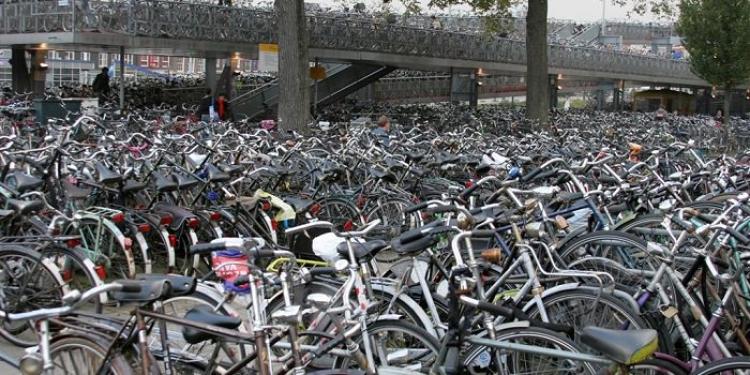How Amsterdam Kept Cyclists On Their Bikes For More Than 40 Decades
Posted: May 7, 2015
Updated: October 6, 2017

The excruciating high number of child traffic deaths led to aggressive activism which transformed Amsterdam into the cycling hub it is today
Did you know that cycling became an integral part of life in Amsterdam because of the alarming mortality rate of children killed by motorists? Indeed up to the 1970s, Dutch cities had cars crawling over them which resulted in an alarmingly high amount of traffic accidents. But thanks to rigorous rooting and a government who eventually listened, cycling is not only a way of life today but has its own very strict rules to abide by.
In this Dutch city, unlike most other cosmopolitan cities, cyclists rule, with motorists resigned to paying high parking fees and moreover, relenting to the glorious agglomeration of cyclists. The accommodation that the city offers cyclists is worthy of envy, as would a gambler winning a million bucks on the beste pokersite in the Netherlands. Moreover, the Netherlands is for the most part less hilly with a mild climate which has always been conducive to biking.
Today, Amsterdam is equipped with an intricate network of lanes and cycle-paths, which exists in all Dutch cities, that the Dutch take for granted. Cycling has become, as has frequenting a Dutch internet casino, an every day part of life. It is safe and comfortable for cyclists and often one comes across toddlers and the elderly in the lanes too. But it wasn't always such a rosy picture.
Believe it or not, 40 decades ago cyclists were under threat of exclusion from circulating freely in Dutch cities because of the high number of four-wheeled mode of transportation. But Amsterdam did not become the bicycle capital of the world overnight. And, even today many old cycle paths still need to be rebuilt to suit modern standards, as they are no longer wide enough.
In the post-war era, when the Dutch economy was doing so well, more and more people could afford cars. Urban legislators supported bills to make cars the primary modern mode of transportation. This meant destroying blocks of residential areas to build roads and make way for 4-wheel traffic. Year after year the number of cyclists decreased as the amount of gamblers increased. The Dutch government tightly controlling gambling within the Netherlands, through Dutch gambling laws, with all casinos managed by monopoly operator Holland Casino.
As traffic grew, so did traffic jams and the death tolls too. Traffic accidents resulted in the deaths of 3,300 people in 1971 alone. Among the dead per year were 400 children. This gave way to protest action especially. The Stop de Kindermoord (“stop child murder”) activist group was born. Former Dutch MEP, Maartje van Putten, who became the president of the protest spoke out.
Putten said “I was a young mother living in Amsterdam and I witnessed several traffic accidents in my neighborhood where children got hurt,” van Putten, 63, recalls. “I saw how parts of the city were torn down to make way for roads. I was very worried by the changes that took place in society – it affected our lives. The streets no longer belonged to the people who lived there, but to huge traffic flows. That made me very angry.”

As activism and civil disobedience became widespread in the 70s, Van Putten recalled how easy it was to approach Dutch authorities. A group of activists biked to the house of the Prime Minister at the time, Joop den Uyl, singing songs. The group was thrown in jail but the Dutch government began to subsidize the group that by then was legally established. Speed bumps and bends, pressuring cars to drive very slowly, were introduced.
Another group of activists founded the First Only Real Dutch Cyclists’ Union 2 years after Stop de Kindermoord was established. This second group asked for more public spaces for bicycles to bike safely. Subsequently, by the 1980s, more Dutch politicians became aware of the many advantages of cycling. Legislators of Dutch towns and cities began introducing measures to make their streets more accessible for cyclists.
Today the Cyclists’ Union boasts a membership of over 34,000 cyclists. The Netherlands has an equivalent of over 35405.568 kilometers of cycling thoroughfares and trails. Wim Bot, a sposkesman of the Cyclists’ Union stated that“We have achieved a lot, but we’re facing many new challenges. We have the problem of parking all those bikes, and we are thinking of new ways to create even more space for cyclists and pedestrians. What our cities really need is a totally new kind of infrastructure. They’re simply not fit for so much car traffic.”
Did you know that cycling became an integral part of life in Amsterdam because of the alarming mortality rate of children killed by motorists? Indeed up to the 1970s, Dutch cities had cars crawling over them which resulted in an alarmingly high amount of traffic accidents. But thanks to rigorous rooting and a government who eventually listened, cycling is not only a way of life today but has its own very strict rules to abide by.
• 1/4 of all trips are made by bicycle
• Sky high gas prices in the 70s drove the Dutch to biking
• The Hague was one the first to introduce special cycle routes
In this Dutch city, unlike most other cosmopolitan cities, cyclists rule, with motorists resigned to paying high parking fees and moreover, relenting to the glorious agglomeration of cyclists. The accommodation that the city offers cyclists is worthy of envy, as would a gambler winning a million bucks on the beste pokersite in the Netherlands. Moreover, the Netherlands is for the most part less hilly with a mild climate which has always been conducive to biking.
Cycling paths need to be broadened
Today, Amsterdam is equipped with an intricate network of lanes and cycle-paths, which exists in all Dutch cities, that the Dutch take for granted. Cycling has become, as has frequenting a Dutch internet casino, an every day part of life. It is safe and comfortable for cyclists and often one comes across toddlers and the elderly in the lanes too. But it wasn't always such a rosy picture.
Believe it or not, 40 decades ago cyclists were under threat of exclusion from circulating freely in Dutch cities because of the high number of four-wheeled mode of transportation. But Amsterdam did not become the bicycle capital of the world overnight. And, even today many old cycle paths still need to be rebuilt to suit modern standards, as they are no longer wide enough.
In the post-war era, when the Dutch economy was doing so well, more and more people could afford cars. Urban legislators supported bills to make cars the primary modern mode of transportation. This meant destroying blocks of residential areas to build roads and make way for 4-wheel traffic. Year after year the number of cyclists decreased as the amount of gamblers increased. The Dutch government tightly controlling gambling within the Netherlands, through Dutch gambling laws, with all casinos managed by monopoly operator Holland Casino.
As traffic grew, so did traffic jams and the death tolls too. Traffic accidents resulted in the deaths of 3,300 people in 1971 alone. Among the dead per year were 400 children. This gave way to protest action especially. The Stop de Kindermoord (“stop child murder”) activist group was born. Former Dutch MEP, Maartje van Putten, who became the president of the protest spoke out.
Stop de Kindermoord held bicycle demonstrations
Putten said “I was a young mother living in Amsterdam and I witnessed several traffic accidents in my neighborhood where children got hurt,” van Putten, 63, recalls. “I saw how parts of the city were torn down to make way for roads. I was very worried by the changes that took place in society – it affected our lives. The streets no longer belonged to the people who lived there, but to huge traffic flows. That made me very angry.”

As activism and civil disobedience became widespread in the 70s, Van Putten recalled how easy it was to approach Dutch authorities. A group of activists biked to the house of the Prime Minister at the time, Joop den Uyl, singing songs. The group was thrown in jail but the Dutch government began to subsidize the group that by then was legally established. Speed bumps and bends, pressuring cars to drive very slowly, were introduced.
New kind of infrastructure required
Another group of activists founded the First Only Real Dutch Cyclists’ Union 2 years after Stop de Kindermoord was established. This second group asked for more public spaces for bicycles to bike safely. Subsequently, by the 1980s, more Dutch politicians became aware of the many advantages of cycling. Legislators of Dutch towns and cities began introducing measures to make their streets more accessible for cyclists.
Today the Cyclists’ Union boasts a membership of over 34,000 cyclists. The Netherlands has an equivalent of over 35405.568 kilometers of cycling thoroughfares and trails. Wim Bot, a sposkesman of the Cyclists’ Union stated that“We have achieved a lot, but we’re facing many new challenges. We have the problem of parking all those bikes, and we are thinking of new ways to create even more space for cyclists and pedestrians. What our cities really need is a totally new kind of infrastructure. They’re simply not fit for so much car traffic.”
Related content
Subscribe
0 Comments












